Eriophyllum lanatum
Eriophyllum lanatum, with the common names common woolly sunflower, Oregon sunshine and golden yarrow,[3] is a common, widespread, North American plant in the family Asteraceae.[4][5][2]
| Eriophyllum lanatum | |
|---|---|
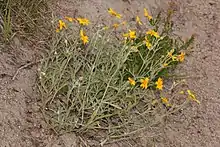 | |
| Scientific classification | |
| Kingdom: | Plantae |
| Clade: | Tracheophytes |
| Clade: | Angiosperms |
| Clade: | Eudicots |
| Clade: | Asterids |
| Order: | Asterales |
| Family: | Asteraceae |
| Genus: | Eriophyllum |
| Species: | E. lanatum |
| Binomial name | |
| Eriophyllum lanatum | |
| Synonyms[1][2] | |
|
Synonymy
| |
Description
Eriophyllum lanatum is a perennial herb growing from 30 to 60 centimetres (12 to 24 inches) in height, in well-branched clumps. Both the stems and leaves may be covered with a woolly gray hair, but some plants lack this. The leaves are 2.5–7.5 cm (1–3 in) long,[3] linear on the upper stems, and slender and pinnately lobed on the lower stems.[2] The hairs conserve water by reflecting heat and reducing air movement across the leaf's surface.[2][3]
The flowers are yellow and composite, looking much like true sunflowers, and sometimes grow to about 5 cm (2 in) wide.[3] Both the (8–12) ray and disk flowers are yellow,[3] with one flower head on each flowering stalk.[2][6] The flower heads have 6–14 rays, which are darker towards the base, and several disk flowers.[7] They bloom from May to August.[4][5] The seeds have scales at the tip.[3]
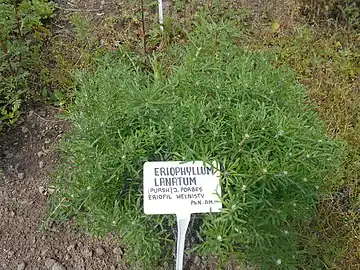 Shrub prior to bloom
Shrub prior to bloom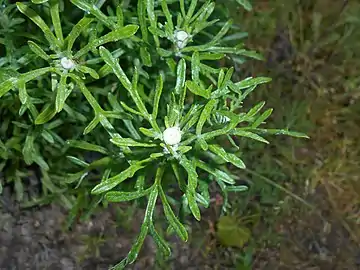 Leaves
Leaves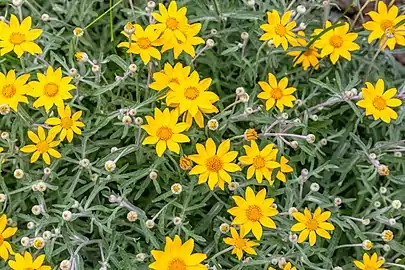 Flowers in bloom
Flowers in bloom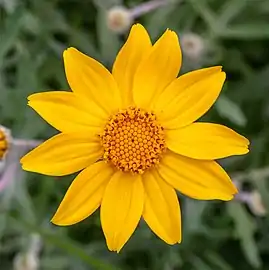 Flower close-up
Flower close-up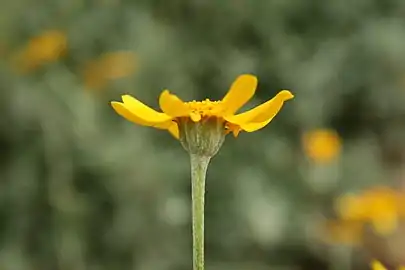 Side view of flower
Side view of flower
Taxonomy
The Lewis and Clark Expedition reportedly saw this plant growing above their camp on the Clearwater River (near present-day Kamiah, Idaho), and collected two specimens on 6 June 1806. Botanist Frederick Traugott Pursh studied the plants collected on the expedition; his first classification and naming of the species, as Actinella lanata, was published in 1813.[8]
The common name "woolly sunflower" is often used to describe any member of the genus Eriophyllum.
Varieties
- Eriophyllum lanatum var. achillioides (DC.) Jeps. — California, Nevada, Oregon.[9]
- Eriophyllum lanatum var. arachnoideum (Fisch. & Avé-Lall.) Jeps. — Spiderweb sunflower; endemic to the California Coast Ranges from Del Norte County to Monterey County in California.[10]
- Eriophyllum lanatum var. croceum (Greene) Jeps. — Sierra woolly sunflower; endemic to the Sierra Nevada in California.[11]
- Eriophyllum lanatum var. grandiflorum (A.Gray) Jeps. — Large flowered woolly sunflower; northern California, Oregon.[12]
- Eriophyllum lanatum var. hallii Constance — Fort Tejon woolly sunflower, Hall's woolly sunflower; endemic to the Tehachapi Mountains in Kern County, and Sierra Madre Mountains in Santa Barbara County, in southern California.[13]
- Eriophyllum lanatum var. integrifolium (Hook.) Smiley — Oregon sunshine; California, Idaho, Montana, Nevada, Oregon, Utah, Washington, Wyoming.[14]
- Eriophyllum lanatum var. lanatum — Idaho, Montana, Oregon, Washington.
- Eriophyllum lanatum var. lanceolatum (Howell) Jeps. — endemic to the Klamath Mountains, in NW California and SW Oregon.[15]
- Eriophyllum lanatum var. leucophyllum (DC.) W.R.Carter — British Columbia, Oregon, Washington.
- Eriophyllum lanatum var. obovatum (Greene) H.M.Hall — Southern Sierra woolly sunflower; endemic to the western Sierra Nevada and the San Bernardino Mountains in California.[16]
Distribution and habitat
Eriophyllum lanatum is native to western North America. It is most common across California,[4] also growing north through Oregon into British Columbia and east through Idaho into Wyoming, and through Nevada into Utah.[4][17] This species has only been collected from Mexico once, on Guadalupe Island, and it is most likely extirpated there.[18]
It can be found (for instance in California) in chaparral, oak woodland, mixed evergreen forest, and yellow pine forest and other conifer forests, grassland, and sagebrush scrub habitats.[4] It commonly grows in dry, open places[3] below 3,000 meters (10,000 feet) in elevation. It prefers full sun and well-drained soil, but it also grows on rocky slopes and bluffs.[7]
References
- The Plant List, Eriophyllum lanatum (Pursh) J.Forbes
- Tropicos, Eriophyllum lanatum (Pursh) J. Forbes
- Spellenberg, Richard (2001) [1979]. National Audubon Society Field Guide to North American Wildflowers: Western Region (rev ed.). Knopf. pp. 373–374. ISBN 978-0-375-40233-3.
- University of California, Calflora taxon report: Eriophyllum lanatum (Pursh) James Forbes
- Sierra Nevada Wildflowers, Karen Wiese, 2nd Ed. 2013, p. 116
- Flora of North America, Eriophyllum lanatum (Pursh) J. Forbes, 1833. Common woolly sunflower
- Taylor, Ronald J. (1994) [1992]. Sagebrush Country: A Wildflower Sanctuary (rev. ed.). Missoula, MT: Mountain Press Pub. Co. p. 144. ISBN 0-87842-280-3. OCLC 25708726.
- Pursh, Frederick Traugott (1813). A Systematic Arrangement and Description of The Plants of North America.
- Calflora: Eriophyllum lanatum var. achilleoides
- Calflora: Eriophyllum lanatum var. arachnoideum
- Calflora: Eriophyllum lanatum var. croceum
- Calflora: Eriophyllum lanatum var. grandiflorum
- Calflora: Eriophyllum lanatum var. hallii
- Calflora: Eriophyllum lanatum var. integrifolium
- Calflora: Eriophyllum lanatum var. lanceolatum
- Calflora: Eriophyllum lanatum var. obovatum
- Biota of North America Program 2014 county distribution map
- Rebman, J. P.; Gibson, J.; Rich, K. (2016). "Annotated checklist of the vascular plants of Baja California, Mexico" (PDF). San Diego Society of Natural History. 45: 58.
Further reading
- Pink, A. (2004). Gardening for the Million. Project Gutenberg Literary Archive Foundation.
External links
- Calflora Database: Eriophyllum lanatum (Common woolly sunflower, Wooly sunflower)
- Jepson Manual eFlora (TJM2) treatment of Eriophyllum lanatum
- USDA Plants Profile for Eriophyllum lanatum (common woolly sunflower)
- U.C. Calphotos gallery: Eriophyllum lanatum images
- Wildflowers of the Pacific Northwest: Eriophyllum lanatum — photos, description, Northwest distribution map.
- Lady Bird Johnson Wildflower Center, University of Texas: Eriophyllum lanatum